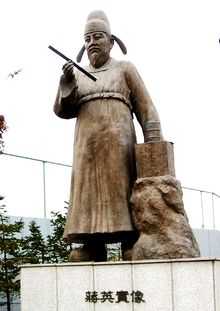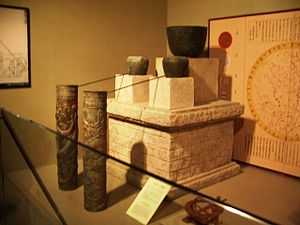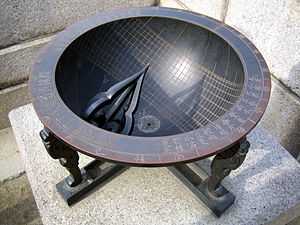Jang Yeong-sil
| Jang Yeong-sil | |
 | |
| Korean name | |
|---|---|
| Hangul | 장영실 |
| Hanja | 蔣英實 |
| Revised Romanization | Jang Yeong-sil |
| McCune–Reischauer | Chang Yŏngsil |
Jang Yeong-sil was a Korean scientist and astronomer during the Joseon Dynasty (1392–1910). Although Jang was born as a peasant, King Sejong's (r. 1418–1450) new policy of breaking class barriers placed on the national civil service allowed Jang to work at the royal palace. Jang's inventions, such as the Cheugugi (the rain gauge) and the water gauge, highlight the technological advancements of the Joseon Dynasty.
Early years
Jang Yeong-sil's birth is recorded only in the genealogy of the Jang family[1][2] and in the Annals of the Joseon Dynasty.[3] According to these records, his father, Jang Seong-hwi, was the 8th generation of the Jang family who came from China.[4] Jang Seong-hwi was the 3rd of 5 brothers and all of the brothers previously were ministers of Goryeo. There are many historical records[5] about his elder brother, Jang Seong-bal, who was born in 1344 and his grave located at Ui-seong in the province of Gyeongbuk. The Annals state that his mother was a gwangi (gisaeng), thereby their (Yeong-sil's and their mother) social status was a gwanno,[6] (a servant in civil service district courts). Yeong-sil's talent was so excellent that he was sent to the royal court. From above, we may infer that Yeong-sil was born in a family of high official status but when General Yi Song-gye unleashed a coup d'état, which gave rise to the Joseon Dynasty, Jang Seong-hwi became a political prisoner and Yeong-sil and his mother became gwannos.
National civil service
King Sejong the Great of Joseon instituted a policy of selecting officials based on their talent, not by their wealth or social class. Jang's fame gained him entry into the royal court at Hanseong (present day Seoul), where selected commoners displayed their talents before the king and his advisers. Sejong saw that Jang met his expectations in crafts and engineering, and allowed Jang to work as a government official in the palace.[7] The talented scientists recruited under King Sejong's new program worked at the Hall of Worthies (집현전; 集賢殿; Jiphyeonjeon).[8]
Astronomical Instruments

Sejong's first assignment to Jang was to build a celestial globe to measure astronomical objects. Books obtained from Arabian and Chinese scholars were not complete in their instructions, for these devices could also be used for military purposes. After two months of study, he made a spherical device that could perform with mediocre accuracy. One year after his first attempt, in 1433, Young-sil made the honcheonui (혼천의, 渾天儀). Honcheonui depended on a waterwheel to rotate the internal globe to indicate time.[9] Whether day or night, this allowed the instrument to be updated on the positions of the sun, moon, and the stars.[10] Later celestial globes (i.e. gyupyo (규표)) could measure time changes according to the seasonal variations.[11] These instruments, along with the sundials and water clocks, were stationed around the Kyonghoeru Pond in Kyongbok Palace and made into use by the astronomers.[12] The success of Jang Yeong-sil's astronomical machines was marked in 1442 AD when the Korean astronomers compiled their computations on the courses of the seven heavenly objects (five visible planets, the sun, and moon) in Chiljeongsan (칠정산).[13]
Iron printing press
Although Choe Yun-ui (최윤의) invented the world's first metal printing press in 1234 during the Goryeo Dynasty,[12] Johann Gutenberg is recognized worldwide as the first to pioneer this technology. In general, metal movable type printing blocks surpassed the wooden counterparts in durability, clarity, and longevity.[14] Even then, the king asked the scientists at Jiphyeonjeon to build a better printing press. In 1434,[15] the scientists accomplished in building Gabinja (갑인자, 甲寅字),[16] which was made of copper-zinc and lead-tin alloys.[17] It was said to be twice as fast as the previous printing presses and print the Chinese characters in astounding beauty and clarity. Gabinja was reproduced six times during the next 370 years.[17]
Water clock

Self-striking water clocks had already been invented by the Arabians and the Chinese (in 1091),[18] and a more primitive form was in use by the Koreans. Although it is believed, Samguk Sagi records that an office overseeing the use of water clocks had been established during the Three Kingdoms Period.[12] The Korean version consisted of two stacked jars of water, with water dropping from the top to the bottom at a measured rate. The level of the water indicated the time of the day. This was very inconvenient because a person had to be always be on guard, so that at each hour he or she could bang a drum to inform the public.
Upon hearing about the usage of self-striking water clocks in foreign countries, Sejong assigned Jang and other scientists to build a clock emulating such automatic devices. They failed in developing an operational water clock. Therefore, Jang went to China to study the various designs of water clocks. When he returned in 1434, Jang created Korea's first water clock, Jagyeokru (자격루).[19] This water clock did not survive; however, reconstructions of the Jagyeokru based on text descriptions have been made.
Circling the clock were 12 wooden figures that served as indicators of time. There were four water containers, 2 jars that received the water, and 12 arrows floating inside the lower container. As the water from the upper containers seeped down the pipe to the lower container, one of the arrows would tilt a board filled with small iron balls; a ball would roll down a pipe to a container of larger iron balls. The collision would cause the larger balls to travel down a lower pipe and hit a giant cymbal, announcing the time to the community. Then, the ball would land on another container, which is part of a complex of levers and pulleys that activates the motions of the wooden figures to indicate time visually.[20]
Sundial

Jang's invention of the water clock saw its infusion throughout the country. Yet, these were very costly, and the cheaper and more manageable alternative came about to be the sundial. Jang, Ichun, Kimjo, and other scientists made Korea's first sundial, Angbu Ilgu (앙부일구) (仰釜日晷),[21] which meant "pot-shaped sun clock staring at the sky".[22] Angbu Ilgu was bronze in composition, and consisted of a bowl marked with 13 meters to indicate time and four legs jointed by a cross at the base.[22] 7 lines crossed the 13 meters in different curves to compensate for the seasonal changes of the course of the sun.[22] Angbu Ilgu and other variants, such as the Hyunjoo Ilgu and the Chunpyung Ilgu, were implemented in strategic spots, such as the main streets with heavy traffic, so that the people could be well informed of the time. To compensate for the high illiteracy rate among the commoners, 12 shapes of animals, such as mouse, tiger, and cow, were engraved in juxtaposition with the meters.[22] No extant Joseon Dynasty sundials today were made during King Sejong's reign, none known to have survived past Imjin wars (임진왜란).
Research on weaponry
When King Sejong learned of reports that Korean melee weapons were duller and somewhat heavier than those of the neighboring countries, he sent Jang to Gyeongsang province, where he had spent his earlier life, to develop metal alloys for various weapons and tools. Since Jang used to be a gwan-no, he had already acquired much knowledge about metal working and also knew the geography of the area. Jang surveyed the available metals and their characteristics, and presented his research to king and the generals, contributing to the development of Korean weaponry.[23]
Rain gauge
The Korean economy during the Joseon Dynasty was agriculturally based and was vulnerable to elongated or consecutively occurring droughts. Therefore, there was a need for better ways to manage water. Although rain gauges had been used in ancient Greece and India,[24] Jang invented Korea's first rain gauge in 1441, called cheugugi (측우기),[25][26][27][28][29] and, by 1442, a standardized rain gauge with dimensions of 42.5 cm (height) and 17 cm (diameter) was introduced throughout the country to gather data on the yearly averages of precipitation throughout the different regions of the country.[8]
Water gauge
To allow better water management, the king asked the scientists to figure out some ways to inform the farmers of the available amount of water. And, in 1441, Jang invented the world's first water gauge, called Supyo (수표). It was a calibrated stone column placed in the middle of a body of water, connected by a stone bridge.[30]
Expulsion
Jang's extraordinary accomplishments earned him much trust of the king. Some government officials were very jealous of Jang, especially when he had achieved so much regardless of his common origin. Furthermore, as Joseon's society was rooted in Korean Confucianism, scientists and engineers were held in low esteem in parallel with craftsmen.
In 1442, King Sejong ordered Jang to build a gama, an elaborately decorated Korean sedan chair. The gama broke while the king was traveling, and Jang was held responsible. Although the king was against the decree, Jang was jailed for a long time, and was expelled from the royal palace. Later events of his life, including the date of his death, were not recorded.[31]
See also
- Printing
- King Sejong
- Joseon Dynasty
- Water Clock
- Sundial
- Hwacha
- Woo Jang-choon
- Science and technology in Korea
References
- ↑ "The genealogy of A-san Jang-si", book 1, pp.4, 1872, (牙山蔣氏世譜卷之一黃)
- ↑ Jonghwa Ahn, Kook-Jo-In-Mool-Ji, 1909, 國朝人物志 v.1, A biographical dictionary of Korea
- ↑ The article of 16 SEP 1433, Chosun Wangjo Sillok, King Sejong
- ↑ Dae-Dong-Woon-Boo-Goon-Ok, 1587, 大東韻府群玉
- ↑ Moon-Ik-Gong Sillok, 1738
- ↑ p. 17 Baek Seokgi. (1987). Woongjin Wi-in Jeon-gi #11 Jang Yeong-sil. Woongjin Publishing.
- ↑ p. 46-49 Baek Seokgi. (1987). Woongjin Wi-in Jeon-gi #11 Jang Yeong-sil. Woongjin Publishing.
- ↑ 8.0 8.1 Korean History Project
- ↑ p. 55 Baek Seokgi. (1987). Woongjin Wi-in Jeon-gi #11 Jang Yeong-sil. Woongjin Publishing.
- ↑ p. 56 Baek Seokgi. (1987). Woongjin Wi-in Jeon-gi #11 Jang Yeong-sil. Woongjin Publishing.
- ↑ p. 77 Baek Seokgi. (1987). Woongjin Wi-in Jeon-gi #11 Jang Yeong-sil. Woongjin Publishing.
- ↑ 12.0 12.1 12.2 Indiana University Resources
- ↑ Introduction to the Folk Museum
- ↑ The Invention of Movable Type
- ↑ Glossary of Korean Studies
- ↑ p. 63 Baek Seokgi. (1987). Woongjin Wi-in Jeon-gi #11 Jang Yeong-sil. Woongjin Publishing.
- ↑ 17.0 17.1 Federation of Busan and Technology
- ↑ p. 68 Baek Seokgi. (1987). Woongjin Wi-in Jeon-gi #11 Jang Yeong-sil. Woongjin Publishing.
- ↑ p. 71 Baek Seokgi. (1987). Woongjin Wi-in Jeon-gi #11 Jang Yeong-sil. Woongjin Publishing.
- ↑ p. 72-73 Baek Seokgi. (1987). Woongjin Wi-in Jeon-gi #11 Jang Yeong-sil. Woongjin Publishing.
- ↑ p. 75 Baek Seokgi. (1987). Woongjin Wi-in Jeon-gi #11 Jang Yeong-sil Woongjin Publishing.
- ↑ 22.0 22.1 22.2 22.3 Kaeri Web Magazine
- ↑ p. 87-91 Baek Seokgi. (1987). Woongjin Wi-in Jeon-gi #11 Jang Yeong-sil. Woongjin Publishing.
- ↑ The Culture and Civilization of Ancient India in Historical Outline; Kosambi, 1982
- ↑ p. 97 Baek Seokgi. (1987). Woongjin Wi-in Jeon-gi #11 Jang Yeong-sil. Woongjin Publishing.
- ↑ Visit Busan Museum Guide
- ↑ American Meteorological Society press
- ↑ Education About Asia, Vol. 6, #2, Fall, 2001.
- ↑ Friendly Korea brief on Korean history
- ↑ p. 101 Baek Seokgi. (1987). Woongjin Wi-in Jeon-gi #11 Jang Yeong-sil. Woongjin Publishing.
- ↑ p. 108-111 Baek Seokgi. (1987). Woongjin Wi-in Jeon-gi #11 Jang Yeong-sil. Woongjin Publishing.
External links
- Newton Graphic Science Magazine, biography (in Korean)
- Youth Korea Times article (in Korean)
- Seoul National University profile (in Korean)